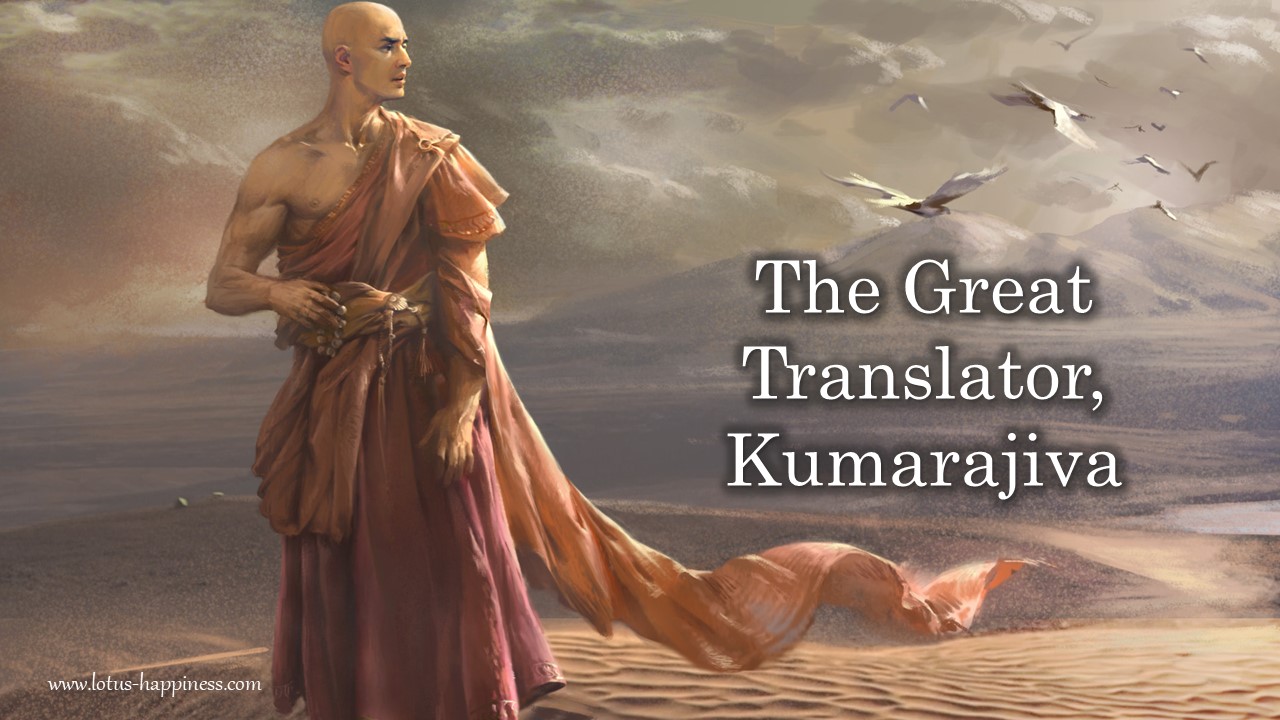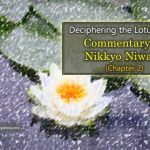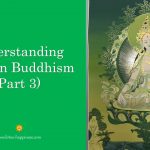The Great Translator, Kumarajiva
Though the Buddhist scriptures are great treasures, it cannot be benefited to the people in China if they are not translated in Chinese. Moreover, if they were translated in deviation to the Buddha’s true teaching, the adverse effect to the learners and practictioners was detrimental. Thus, the translators must be talented scholars with excellent knowledge in Buddhism, fluency in writing and proficiency in Sanskrit and Chinese, etc. The status of translators in Buddhism is comparable to many great Dharma masters, which is remarkable in history.
In summary, around 6000-7000 fascicles of the sutras were transmitted to China and translated in Chinese during 2nd century and 13th century. There were almost 200 prominent translators during those years. Amongst them, Kumarajiva was the most prominent one in the early years (i.e. at 5thcentury), while Hsuan-tsang was another one in later years (i.e. at mid 7th century).
Kumarajiva (344-413 A.D.) [鳩摩羅什]
Before Kumarajiva, there have had several hundred sutras translated into Chinese. However, the profound doctrine of Buddhism was not yet transmitted, as the Chinese translators did not fully and truly understand what the Buddha taught. The situation changed when Kumarajiva started his translation works in China.
Kumarajiva (344-413 A.D.) was born in Kucha [龜茲], in Central Asia. His father Kumarajana was a Braham from India, while his mother, Jiva was the prince of Kucha. Kumarajiva was named Kumara after his father and Jiva after his mother.
Kumarajiva’s mother was a wise woman, who could understand sutras being recited. She became a nun when Kumarajiva was seven years old. Kumarajiva followed her mother and learned Buddhist sutras. Like his mother, Kumarajiva could recite a thousand sutras / verses from memory.
He went with his mother to learn Agama sutras and other Hinayana scriptures under the noted monk Bandhudatta [盤頭達多] in India and Buddhayashas [佛陀耶舍] in Kucha. Later, the prince of Yarkand called Suryasoma taught Kumarajiva the theories of Mahayana Buddhism. Kumarajiva had said, “I thought Hinayana Buddhism was the best teaching before I studied Mahayana Buddhism. I was like a man who does not know of gold, and thinks brass is the best”.
Kumarajiva became a fully ordained monk at the age of twenty, taking the precepts that Buddhist monks followed. Kumarajiva was well known in his country Kucha and the neighboring countries. Later he invited his former teacher Bandhudatta to study Mahayana Buddhism. However, his mother encouraged Kumarajiva to carry the true teachings of Buddhism to China, when the famous Chinese monk Tao-an [道安] and the King wanted to invite him to China.
Eventually, 16 years after the death of Tao-an, Kumarajiva arrived at Chang-an [長安] and was welcomed by the King Yao Hsing [姚興] in 401 A.D. Kumarajiva was already over fifty at that time.
Yao Hsing honored Kumarajiva with the title of National Preceptor, and asked him to be in charge of translating sutras in Chinese. Many followers of Tao-an gathered around Kumarajiva to learn the profound teachings of Buddhism. In return, they helped Kumarajiva with his translations.
Kumarajiva was highly respected. The King Yao Hsing had provided him and his colleagues with large buildings where they could work together in translating sutras. The King himself sometimes participated the works as well.
Before Kumarajiva died, he proclaimed that if his translation was in accord with the genuine principles of Buddhism, his tongue would be intact and not turn to ash.. After incineration of his body, the tongue was not damaged.
Major Scriptures translated by Kumarajiva
Between 401-413 A.D., Kumarajiva translated 74 scriptures in 384 fascicles in total, including:
- Satyasiddhi Shastra, i.e. Treatise on the Completion of Truth [成實論]20 fascicles in 402-412 A.D.
- Astasahasrika Prajnaparamita Sutra i.e. the Perfection of Wisdom Sutra [小品般若波羅蜜經]10 fascicles in 408 A.D.
- Vajracchedika Prajnaparamita Sutra i.e. the Diamond Sutra [金剛般若波羅蜜經]1 fascicle in 402-412 A.D.
- Saddharmapundarika Sutra i.e. the Lotus Sutra [法華經]8 fascicles
- Smaller Sukhavati-vguha, i.e. the Amitabha Sutra [阿彌陀經]1 fascicle in 402 A.D.
- Madhyamaka-shastra, i.e. the Treatise on the Middle [中論]4 fascicles in 409 A.D.
- Shatika-shastra, i.e. the Treatise in One Hundred Verses [百論]2 fascicles in 404 A.D.
- Dvadashamukha Shastra i.e. the Treatise on the Twelve Gates [十二門論]1 fascicle in 409 A.D.
- Sarvastivadin Vinaya i.e. the Ten-Category Vinaya [十誦律]61 fascicles in 404-409 A.D.
- Mahaprajnaparamita Upadesha, i.e. Treatise on the Great Perfection of Wisdom Sutra [大智度論]100 fascicles in 402-405 A.D.
- Panchavimshati Sahasrika Prajnaparamita Sutra i.e. Perfection of Wisdom Sutra in Twenty-five Thousand Lines [摩訶般若波羅蜜經]27 fascicles in 404 A.D.
- Vimalakirti Nirdesha Sutra, i.e. Vimalakirti Sutra [維摩詰經]3 fascicles in 406 A.D.
- Karunikaraja Prajnaparamita Sutra [仁王般若波羅蜜經]2 fascicles
- Maitreyavyakarana Sutra [彌勒下生成佛經]1 fascicle
- Shurangama-samadhi Sutra [首楞嚴三眛經]2 fascicles
- Brahmajala Sutra, i.e. Brahma Net Sutra [梵網經]2 fascicles
- Dasabhumikavibhasa [十住毗婆沙論]17 fascicles
Kumarajiva’s translation was very important to Buddhism in China because he brought in true Buddhism. Moreover, Kumarajiva’s works contributed to the development of Pure Land Sect, Tien-tai Sect, San-lun Sect, etc., as his translated sutras were always taken as their principal readings.












